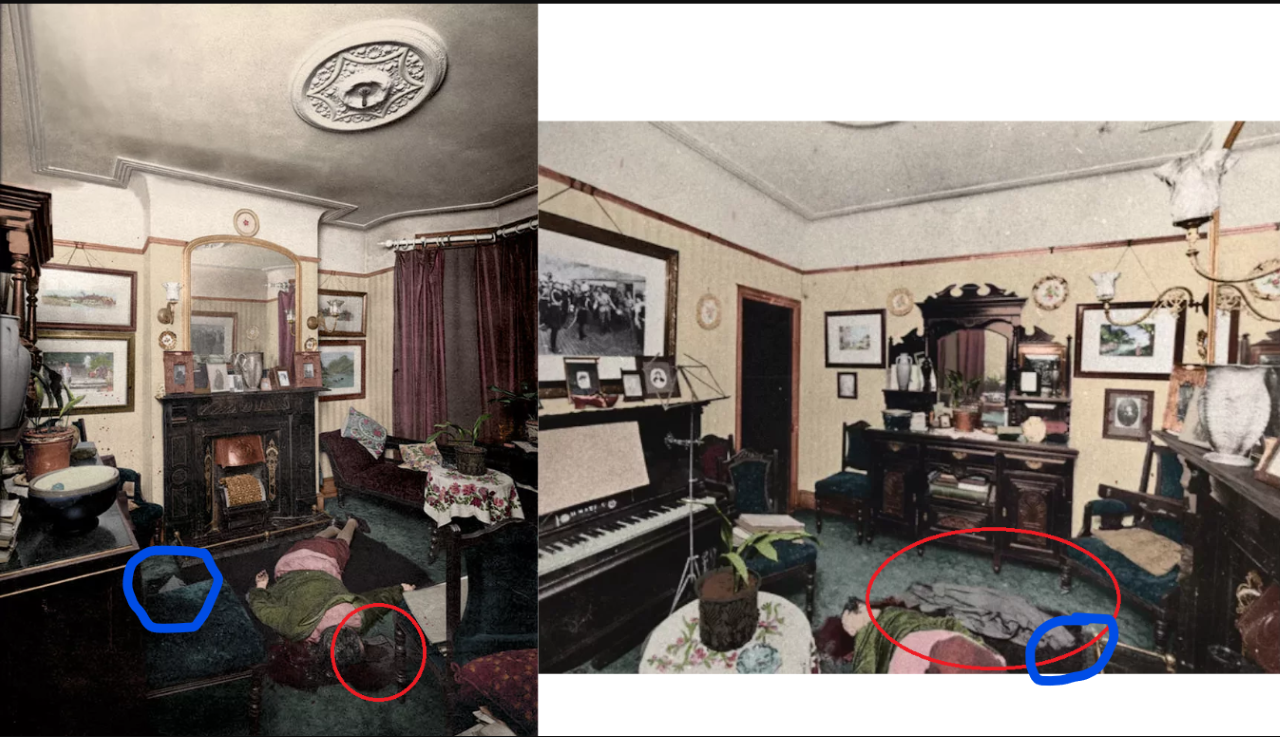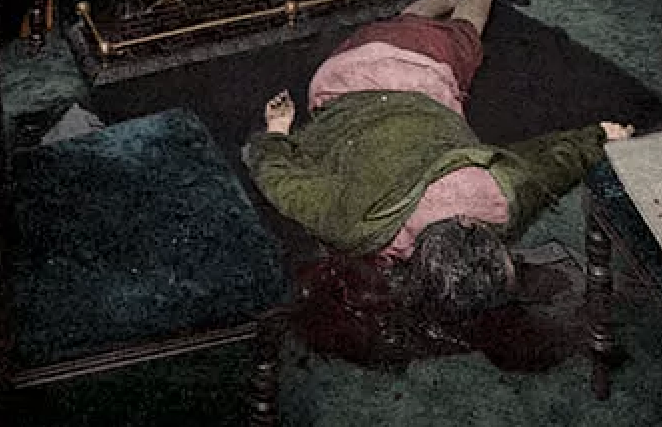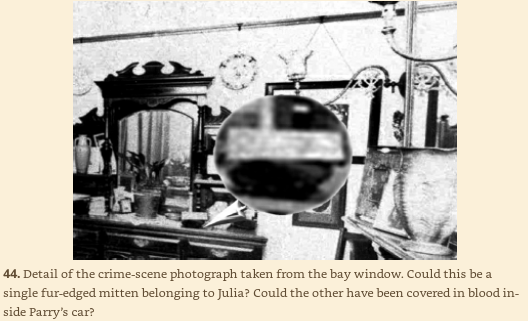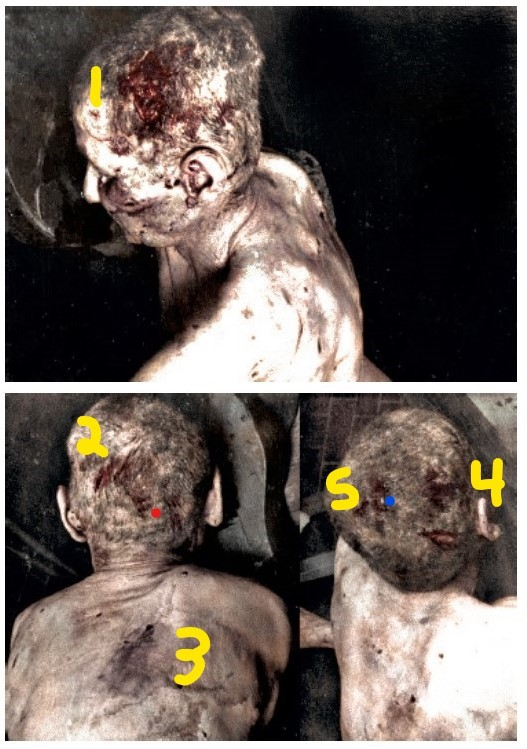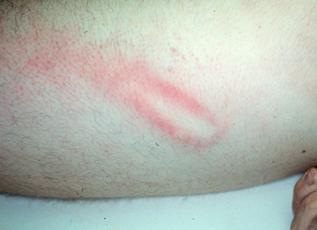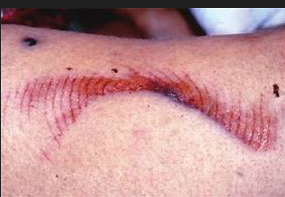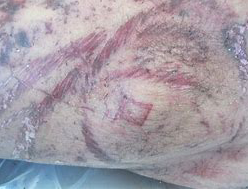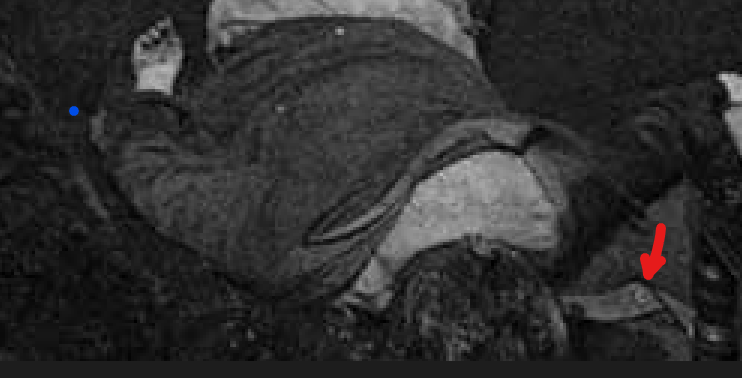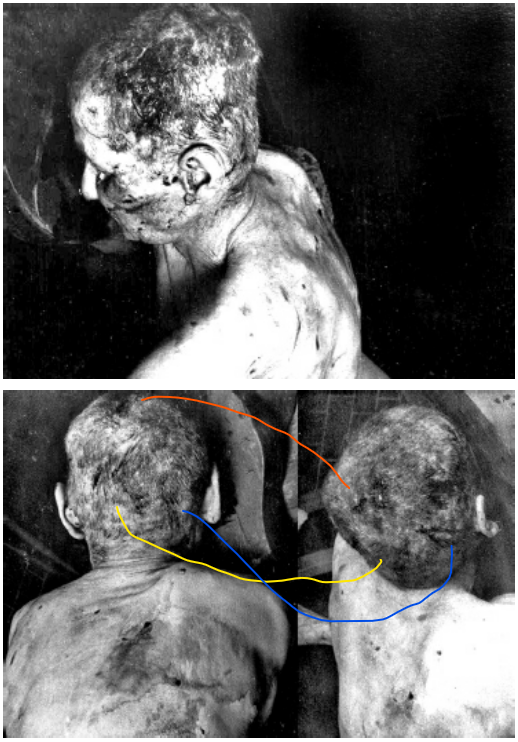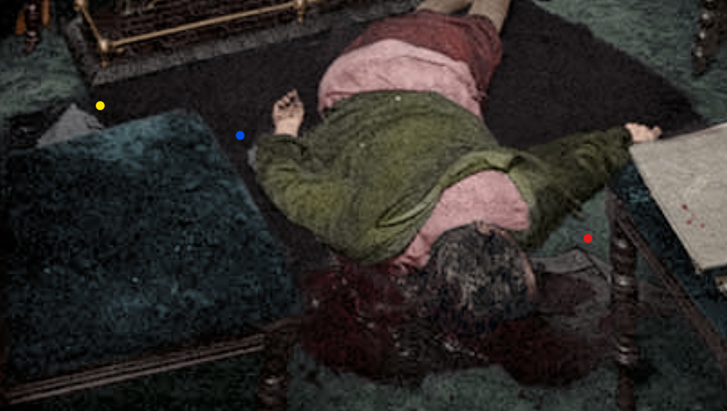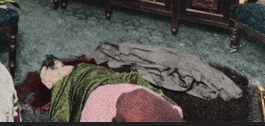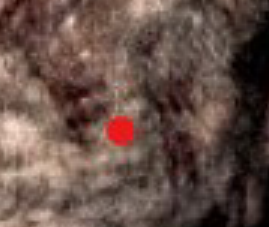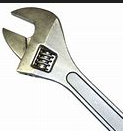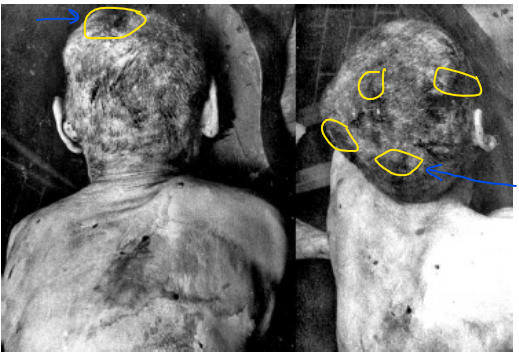Here is my correspondence with another forensic expert I hired. He is a doctor in forensic science and has worked as the chief medical examiner for several police forces. He has testified as the expert witness in hundreds of court cases and is tasked with investigating cases of suspicious deaths. He was the forensic consultant for the TV shows “CSI,” “CSI Miami,” “Bones, Rizzoli & Isles,” “The Blacklist” and “Rosewood.”
His comments are in bold, mind are unbolded.
—
Hello,
Wow. Clearly there has been a lot of work done on this case by many. I see also that you have reached out to several of my colleagues. I am not sure from your email what all you would like me to examine. There is a lot of information on your website but a proper examination should be of higher quality photos than you probably have posted. I assume that you have some higher resolution pictures that could be sent so that they could be enlarged while viewing. In addition, have you scanned any or all of the documents electronically? That would allow me to search for items of interest.
If you are interested, below is a link to a cold case practice document which just came out from the US NIJ. I was one of the authors.
I’m using Adobe Acrobat.
You can view “NIJ 19-National Best Practices for Implementing and Sustaining a Cold Case Investigation Unit.pdf” at: https://documentcloud.adobe.com/link/track?uri=urn%3Aaaid%3Ascds%3AUS%3A301e9629-7d30-4fb3-a850-267118be54eb
I will say from the information below that there would be a lot of expected cast off of blood from the multiple blows. I have not seen the exact information you discussed earlier, but if the story is that Wallace was convicted on the basis of him “holding up the raincoat as a shield” while simultaneously striking the blows, I would say that is absurd. Now if he was wearing a raincoat, it could largely protect the underlying clothing.
—
Some small points sound misleading in Gannon’s book especially but I will be able to clear that up for you as you come across anything that seems off (e.g. he says she was in the “two seater chair” with her head to the right, which makes it sound like he means the lounger… But McFall actually says the total opposite, the armchair to the left of the fireplace… So unless there’s another report and McFall totally reversed his opinion, then it is the chair on the left.
—
I am hoping you could clear something up for me. Have been reading the Gannon book and several times he speaks to Julia’s body being moved. However, to my examination based on the parlor photo from the door (parlour-colourized-1) and from the window (parlour-colourized-2) this does not appear to be the case. In addition, the grey mackintosh laying next to her right arm in 2 can also be seen in 1 – just beyond the blue chair in front of the sideboard. So it appears to be in the same location in both.
Or is he speaking about other photos? Those are the only two scene photos I think I have.
With regard to the “two seater chair” I do believe it is the one to the left of the fireplace. That chair (with the violin case) seems wider than the other chairs in the room. Is that a British term?
And who is RM Qualtrough on the web site? Is this a pseudonym? Who runs the web site?
—
Hi there,
Gannon’s book while it has a lot of information can be hard to read in some parts so I’m glad for the opportunity to clarify some things. The “two seater chair” is the chair to the left of the fireplace. It’s not a British term (I’m English), it’s am armchair, I don’t know what he’s talking about there.
So the first strike according to McFall hits Julia on the front left upper side of the skull (the giant open wound you see on the post-mortem photos) while she is sitting in the armchair leaning forward “as though in conversation”.
The two photos have the jacket in different places, let me do a circle round them real quick:
https://i.imgur.com/i0TuIa9.png
So on the photo on the left, the mackintosh is on the right side of Julia (as in the window side of the room). On the photo on the right, the jacket has been taken out completely from beneath her (by investigating officers or the photographer) and laid out flat and away from her body on the left side of Julia (as in the sideboard side of the room).
In regards to Julia’s body being moved, I think this is said because if she’s struck in the armchair (that is on the left of the fireplace – the sideboard side of the room), it’s hard to reconcile with how her feet ended up on the opposite side (the window side of the room). Also the burning etc, the burning is a very confusing point.
In other words the body wasn’t moved between the photographs being taken, but moved after Julia was first hit compared to when she was discovered.
The website is owned and run by myself and a friend interested in the case, and “RM Qualtrough” is a psudonym we use just for fun since it ties in with the case.
Of course Julia having been in the armchair etc. is “according to McFall”, and you may have your own ideas about where she was first struck etc. or even what the first blow was.
—
Calum,
I agree with your assessment of Gannon being a mess. He requotes frequently and puts in pages of history which have only minimal contribution to the case. Great info but difficult to follow. I just finished on the Kindle last night and have gone on to the Wilkes and Goodman books. I hope to review the trial transcript today but that requires me being at my computer rather than the Kindle. Do you know whether the Hussey book is available there in England at a reasonable cost? It seems like it would be an interesting read. But to buy here in the US it would be nearly $50 US.
With regard to the photos and the Mackintosh see what I have circled below. To my eye the corner of the Mackintosh is seen just beyond the edge of the chair on the hearth rug just to the side of her left hand. Clearly to me if what you circled under and next to her head is a grey Mackintosh, and I would agree, it would have to be a different one. I also see no blood on the one laid out on the floor. But there is clear blood on the grey item beneath the head. I am hoping reading the trial transcript will clear this up. The b&w photo from the doorway (from criminalia.es) seems to have better resolution. Do you have a similar b&w photo taken from behind the settee? I do not see that on the web site.
With regard to the settee (next to the window) and the wide armchair (“two seater chair” might be his use since the armchair is wider than the other chairs) to the left of the fireplace:
The settee does appear to have pillows arranged for someone who is reclining, as Gannon states. But apparently there is no blood in that corner of the room. All of the blood is around the armchair. But… the violin case is lying on the arms of the chair. It would seem clear that someone was not sitting in the settee when the attack started due to lack of blood and was not sitting in the armchair either. I actually favor at present Julia bending down at the fireplace (but not to light the fireplace, as Gannon makes a case that the fireplace had been on, and it would likely be on for some time in order to be hot enough to burn the Mac and her dress) as McFall apparently says when questioned by Oliver. If so, she might fall against the hot fireplace when first struck.
With regard to the fur edged mitted mentioned by Gannon, try as I might I cannot see that clearly in the photos I have (his enlargement – photo 44 – is too fuzzy to conclude). Are you convinced?
So may I assume you live in England? The reason I used “British” is that there have been references to other areas in Britain, such as Wales. And, if you are a lexicologist, any idea why it is British but Britain (with the a)? Bit confusing to us across the pond. ?
Finally, if I am able to be of assistance, I was wondering about presenting this case at a forensic meeting. The American Academy of Forensic Sciences meets yearly in February. There are two venues that would be appropriate. The first is an evening session called “Last word” where presenters are given around 30 min to present a historic case to the assembly. The second would be at a breakfast seminar, where similar topics are given an hour. Thoughts? A great way to get the best forensic scientists from around the world to consider the case.
—
Hi there, thanks very much for your deep dive! Curious, are these emails I’m sending getting to your mediacombb.net email address or to your other? Outlook keeps claiming it’s failing to send so I’m worried you’re not getting my messages.
There are very high resolution enlarged photos of the crime scene in here:
https://www.ebay.com/sch/i.html?_from=R40&_trksid=m570.l1313&_nkw=Murder+Casebook+25&_sacat=0
I tried scanning but it loses all quality when scanned. There is so much more detail you can see with the images in front of you and such high res as they are in that photo.
I agree with you about the material you have circled in blue. I always took him at his word that the jacket was laid out beside her and that it was that. It appears the photo was taken in the very early hours of the morning judging by the clock in the room [edit: I meant the kitchen, this was some days after, my mistake], so maybe it was a sheet of some kind to cover the corpse after McFall had left.
I’m interested about her having not been in the chair. It fits the evidence with the burning better, so I’m wondering now what she was doing down there, because the gas tap which controlled the fireplace was on the right side of the fire unit. Because of the lack of defensive wounds despite the attack coming sort of front-on, I wondered if that might be because she was getting up when hit? I quite agree it’s weird someone would sit in a chair with a violin case across the armrests… McFall hypothesized she had been perched on the front end of it, he claims he tested it himself but then again as an investigator he seems a bit iffy (forgot to even take the temperature of the room for example, or use the most up-to-date forensic methods of the time to ascertain the time of death).
The circled “mitten” by Gannon is often disregarded as it really does seem he’s grasping at straws just circling some random object.
I’m afraid I don’t know about the British vs. Britain thing haha, I do live here, I’m just a bit outside of London.
I would be very excited if you were to present this case at those meetings!!! It is such an interesting case as well, it’s sure to be a hit. The “real life whodunnit” as it’s often called.
—
The grey item on the side of the body does seem consistent with a mac. I am trying to find someone who states which one was held up for Wallace to view when he noted the repaired areas and stated it was his. And if this was done before or after the photos (my assumption is before). Why they would not hold up the one under the head would be odd, but replacing the bloodstained one under the head before taking the pic would be very odd – but consistent with the other items they examined and replaced.
As far as what she was doing, it probably makes no sense that she was turning on the fireplace. It appears that the fireplace would have had to been on for some time to cause the 3 parallel burn marks. But she could have been reclining on the settee and then got up to meet the person and was struck when she got to the left side of the fireplace. If she approached someone from the settee a right handed person would have struck her on the left side of the head if they were facing each other as she was passing him on his left while he faced her. But that would imply that either the caller broke in, was able to get in via a key or unlocked door, or had been there for some time. The last appears a bit unlikely given the limited time frame. If we reverse positions and it was him reclining on the settee with her standing near the sideboard, as he approached her he would strike on her left side and get blood cast off toward the wide chair with the violin case. But the main issue I have with the blood seems to be that I do not recall seeing information on blood spatter on that chair or on the case, which would be odd if someone was not seated on the chair in front of the case. Am I correct about the spatter pattern?
One thing that struck me last night while reading Wilkes… It was noted that MacFall said death was w/in 4 hrs when he arrived at 9:50 pm. Then Pierce arrives at 11:50 pm and concludes death 6 hrs before. Both of those observations are identical and indicate a time of 5:50 pm for the killing, which is while Wallace is at Miss Miller’s and before he came back home for tea. Very odd that they both describe identical rigidity even though 2 hrs had passed. But there is no disagreement, just an impossible timeframe. Then the observation of the clotted blood has MacFall say it was 2-3 hrs old and indicates a time of 6:50-7:50 for the killing. This is much more plausible but is after Wallace leaves. It appears that Alan Close delivered the milk right around the time Wallace left for Menlove. If you rely on Wildman, he says he sees Close at 6:38 pm, which would be before Wallace left. But no matter what, those two stories have Julia alive at the back door, leaving Wallace no time to kill her, clean up and end up getting on the #4 tram at 7:06 pm.
With regard to the doors, have you ever considered that the assailant was in the home when Wallace got back? The doors were locked and he escaped after Wallace had tried both doors and couldn’t get in? The sequence appears that Wallace tired the back door (which would be his norm) then tried the front and couldn’t get in that way either. Then he rushed back around to the back door, passing the Johnsons in a hurry, and found the back door now unlocked. It would seem that it would take Wallace a couple of minutes to walk from the back to the front, then a bit less time to go back to the back as he was rushing.
But to your original question.. I see no way that anyone could have committed the murder without getting seriously blood stained. And then certainly have done it in the time frame allotted.
More to come…
—
The mackintosh thing is so very unusual! Because the time the photograph was taken I wonder if the thing laid out beside her really is a mackintosh or if it’s some sort of covering they put over the body and then moved aside for the photo. It’s so peculiar particularly because not once is it mentioned on trial (that there are two)… No reference to what the other bit of fabric is can be found anywhere by me.
The grey item on the floor certainly looks like a mac to me. Too short to cover the body. But I still find it very odd that there is one under the head too. Very important which one was held up for Wallace to inspect. Even with their mistakes, I cannot envision them taking out the one under the head to show him then replacing it under the head. It would be good to know when the pics were taken and when they showed the mac to Wallace.
I agree she was likely not turning on the fireplace as the gas tap is on the right side of the unit, and if she’s more to the left, I don’t know that she would reach it from there. But it depends how close to the chair she is.
Fireplace was more likely already on before the encounter. And then she brushed against it. But then she would have to be standing/pushed inside the fireplace fender.
There is blood along the top of the violin case according to McFall (not visible in photographs), and – according to Gannon, there was blood upon the flat cloth looking thing (noted as being a cushion by the City Analyst) that you see on Julia’s chair. This is what he says:
“In his report, the City Analyst stated that on the cushion, ‘There were numerous small Human Blood Stains on one side, together with particles of the burnt Mackintosh.’
Gannon, John. The Killing of Julia Wallace . Amberley Publishing. Kindle Edition.”
The benzidine test was applied to Wallace’s clothing on the night of the murder according to author Antony M. Brown, and no traces of blood were present. I just read that while looking for corroboration on the cushion blood marks and thought it ought to be mentioned. I noticed you said this:
“But to your original question.. I see no way that anyone could have committed the murder without getting seriously blood stained. And then certainly have done it in the time frame allotted.”
Wondering if you mean even if the mackintosh was worn? If so then that is definitely a massive thing, because the prosecution case relied entirely upon that jacket having been worn as a shield, with or without clothes on underneath.
Yes, even if worn. There would still be spatter on the attackers face and neck (and hands unless wearing gloves). And on the lower pant legs and shoes, since a mac does not drag on the floor. And I can’t accept it being used as a “shield”. You simply can’t hold up a coat like that and protect your entire body. We know from the spatter at the scene that it was not placed over the head for all blows (if any). And if it was over the head for “some” of the blows the lab should have been able to detect defects – most likely true tears – in the material. Absent that, unless we think the lab was incompetent too, I do not think the mac was ever over the head when it was being hit. As I think it was accepted that Julia was alive when the milk boy arrived, the concept of Wallace being naked is simply absurd to me. Not enough time for all that and still make it to the tram. And I actually have a lot of trouble believing that anyone involved in this murder was that calculating. It seems to be either a crime of passion or an offender who panicked. With “overkill”. In my opinion offenders like that are not nearly so neat nor do they plan so well.
I did consider someone may have still been in the home (Wallace thought so too), but what made me unsure about that was the fact that when Wallace first went round to the back yard, the yard door was unbolted, though it was his wife’s practice to keep it on bolt. The door into the scullery/back kitchen was known to be defective and stuck sometimes. I figure if someone was still in the home, the yard door would still be bolted, but if he escaped out the back he would have unbolted it to get out.
I would think it would be possible that the attacker had come in via the yard door and left it unbolted. Then when he got (or was let) in, he bolted the kitchen door. The fact that Wallace found the yard door unbolted seems to indicate someone other than Julia had gone through that door. And even if let in, Julia may not have bolted it since she felt safe with the visitor. Seems she only bolted it when home alone.
The sequence is in fact that Wallace would leave by the back door (and his wife would bolt it behind him), but, because he had his key, when he got back home he would enter through the front door. So he went front -> back -> front -> back and the Johnstons are there and the door opens.
It was unclear to me what his “normal” habit was. I thought I had read that he normally came in and out via the back door. But if he comes in normally from the front, after he tried that door (bolted) it would take some time to go around to the back. More time to go to the front again. He then gets panicked and rushed to the back the second time. The attacker could have escaped from the front or back during that time.
About reclining on the settee I see the cushions are sort of scrunched up there but again it’s a Gannon thing and I’m not sure I’d say anyone had been reclining in it. And also the police made almost zero effort to preserve the crime scene at all, they were just touching and moving things around without a care in the world, and I can imagine the investigators sitting on that sofa… But with that said, Julia had been poorly, she had bronchitis at the time of her death, so lying down may have been more comfortable to her.
To show what I mean about the extreme movement and tampering of the crime scene:
https://www.williamherbertwallace.com/gallery/crime-scene-photos/
If you look at the two bathroom shots, on the floor a weight type thing or toilet brush holder is moved, and what appears to be a couple of rag-like things have been removed entirely as well as a bar of soap… In the “living kitchen” where the cash box was kept, there were originally 3 coins on the floor at the base of that bookcase and cupboard thing the cash box was on top of, yet they are not present in the photo. The cabinet lid referenced as being removed was also on the floor and I do not see it in the photo.
But wouldn’t it be hidden by the table and wicker chair? And could you clarify for me if you know exactly where in the kitchen the cabinet with the missing door is? I am unclear on that. Wallace just “pointed at it”.
In the parlour, the chairs are moved and the mackintosh is not in the original position. On trial, Florence Johnston said the photographs looked like a “faked room”, presumably because everything had been tampered with so much. They describe the original positions quite well fortunately.
The chain of the sink stopper also has been moved.
What interested me is that you said the killer would be right handed if Julia approached from the settee and he hit her. Does that imply a left handed killer if the positions are reversed (Julia on the sideboard side of the room, attacker on the opposite side)? One of the suspects is left handed apparently, but that tidbit is according to an author who doctored and falsified case files for his book so I’m not sure of the validity.
No matter where they are in the room, if facing each other a right handed person would be most likely to strike the head on the left. If behind her a right handed person would be most likely to strike on the right side. Once she is on her stomach on the ground with her chin facing her left shoulder (as in the photos) the left side of her head would be up and either a right or left handed person could inflict the blows.
I think the trial text will help a lot forensically, as McFall is questioned at length and described a lot of blood patterning which isn’t visible in photos due to the technology of the time.
Agree.
—
Thank you very much for your reply. Just to go one step further, the usual “shield” suggestion used these days is that William first hit his wife, then knelt to deliver the rest of the blows while wearing the jacket. What would you make of that? There are many variations upon the blood shield idea floating around, many seemingly involving him being fully dressed under it and finding some way to avoid getting even a drop a benzidine test could detect upon any of the clothing. I suppose a century of speculation might be to blame for all the speculation!
Anyway, regarding the mackintosh, I suspect the one that was held up for Wallace was his own, as he says he had seen his own jacket beneath Julia’s body. Whether it was then put to the side or back under her I don’t know, I’m not sure which of the two it is (and it’s crazy this was never pointed out or mentioned anywhere before).
My grandpa, who has a very keen eye, also noticed this:
https://www.williamherbertwallace.com/wp-content/uploads/2020/01/iron-bar.jpg
He told me the “12 inch by 1 inch piece of iron” that was kept by the fireplace was not missing, it’s there in the photo. If that truly is the piece of iron, then it might be the case that with the extreme level of police interference around the crime scene that object was moved, and when the charwoman walked around the house she thought it was missing when she didn’t see it in its usual spot.
The only thing about the attackers still being in the house is, a witness (Anne Parsons) claimed to have seen men running away from the scene nearby at a bit after 20.00, she says she thinks nearer 20.15. Wallace did not arrive back at Wolverton Street until about 20.40-ish, so if those were the men then they were not still in the home unless she was off about the timing.
RE: “[Regarding the coins/cabinet lid:] But wouldn’t it be hidden by the table and wicker chair? And could you clarify for me if you know exactly where in the kitchen the cabinet with the missing door is? I am unclear on that. Wallace just “pointed at it”.”
I actually don’t know either. And I assumed the coins were at the base of the unit, so possibly covered by the chair but there’s a fair bit of floor visible down there, it’s speculation on my part they were moved. The cabinet with the lid has never been properly identified by anyone, my guess is probably as good as yours as to what it is, but I THINK it’s this:
https://i.imgur.com/TXrYcmz.png
I don’t really know. It’s been called a cupboard, a box, a cabinet, and the door called a door, a lid… It’s difficult to say.
Regarding the trial text, there is the PDF text format online but it is missing information and is abridged in parts (which can omit useful information or fail to show that a witness was very unreliable), I think I sent this before but it’s here:
https://ia601606.us.archive.org/13/items/in.ernet.dli.2015.220695/2015.220695.The-Trial_text.pdf
And the full unabridged version is public on my site but in image format:
I made it a little easier to find information by providing a table of contents that hyperlinks to the relevant pages where testimonies begin, but generally the text format will be easier to work with as you can use the Find function of your browser etc. I am very excited for your opinions after reading through the testimony of the forensic professor McFall etc. as there is a lot of detailed information there about the blood and shape of the markings etc.
Regarding blood on items and so on I have this from Antony M. Brown who is an author I have been in contact with, I inquired with him about the blood on the cushion and violin case which you asked about in a prior email:
“The police removed the following items from the parlour:
– Mackintosh (singular)
– Hair
– 2 pictures
– 2 photographs
– Violin and case
– Music
– Cushion (not specified, presumably from armchair)
– Hearthrug
The analyst said there were numerous human blood stains on one side of the cushion, together with pieces of burnt Mackintosh. The outside of the violin case had many blood stains. The sheet music was spotted with human blood. One photograph had four blood splashes, the other a blood smear.
No mention of two mackintoshes – only one. Cushion contains pieces of burnt mackintosh (BUT this is quite likely contamination from the police holding it up, in my view). Interesting that there is a smear (not a splash) on one photo.
Interesting that it is two photographs and two pictures. I can see a spot of blood on the square photo (on wall facing window). I think the rest of the framed articles are pictures by the armchair. If so, which other photo was it? Pure speculation, but I might be able to see a spot of blood on the left-most photo on the mantelpiece but this is just a game of interpreting dots on a grainy image!”
I think the HD images in the magazine will prove very helpful for you, it’s my favorite publication on the case for the images… If there is blood on the cushion thing on the armchair (Gannon claims there was, but it’s not actually specific which cushion it is and there are numerous in the room) and on top of the violin case etc, would that change your opinion on the positions of Julia and her attacker?
Thanks! ?
—
Calum,
Sorry I have not been in touch recently. I am nearly done with the trial and am taking notes. Brown also arrived yesterday and I am looking forward to reading it.
It has been a bit busy recently with upcoming trials and a bunch of grants that I have to review in the next couple of weeks for the US NIJ. But I certainly have not forgotten you! And I look forward to hearing your theory.
—
Calum,
Done reading the trial. A bit of a challenge doing it on a PC so that I can highlight. I will be interested in your ideas. I thought Anthony Brown’s book was pretty good.
I remain convinced that William was not the killer and I am not very excited about the accomplice theory. I just don’t think he was involved. The involvement of Parry seems pretty clear, especially with the glove and car wash.
Hope to hear from you soon. I would still like to present this at AAFS in February assuming that we are back to in-person meetings by then. Would you be interested in attending?
—
Hi there, in regards to what happened there’s a few ideas:
1) I think the first event was not necessarily a strike but a push towards the fireplace and this causes the burning?
Julia may have hit her head on the mantlepiece and been dazed or knocked out. Maybe killed. Then pulled out of the fireplace by her hair and jumper.
I agree that she likely was pulled by the hair into the center of the room. The problem with hitting her head on the mantle with any force is that there should be hair/blood/tissue on it. But it is possible she was shoved into the mantle and received a blow to the head which stunned her.
I’m not sure hitting her head on the mantlepiece to cause that massive wound on the left of her head fits the forensic evidence, I wanted to ask you your opinion on that.
It seems the left of her body went into the fireplace though, based on the skirt burns. I am told the placket should be worn on the left hence the left side of her body facing the fireplace when pushed into it, but the location the placket should have been seems to have been an educated guess rather than known fact.
2) I think there’s a chance that neither the poker nor iron bar is missing from the house.
On the fender of the fireplace there’s a piece of iron which has a handle. Whether or not a handle was on the iron bar the charwoman usually used I can’t remember 100% if it was stated – but I think there was not a handle.
I do not recall a statement about a handle on the iron.
But she did mention a handle being on the pokers. So I think it might be the fireplace poker from the kitchen on the parlour fire’s fender.
You probably are thinking why a poker would be with a gas fire.
I think the iron bar had fallen down the crevice behind the fireplace as per Goodman. The charwoman had not attended in a few weeks or something due to the death of her husband, so I think cleaning duties were then left up to Julia.
Because the iron bar is “missing” (down behind the fireplace in that crevice) I think Julia has brought in a poker from the kitchen as a substitute to do the same job of clearing our cigarette ends and spent matches from beneath the fire.
I like that idea.
A close up of that object on the fender:
https://www.williamherbertwallace.com/wp-content/uploads/2020/01/iron-bar.jpg
So if both things are still in the home I don’t know what was taken or used to hit her. If the attacker had brought an item of their own it seems to raise the odds of this being a murder and that has given me doubt about my idea.
I don’t know for sure what that thing on the fender is but it’s something.
Does look like a poker to me.
3) I think perhaps the crime went like this… The call was made by Gordon or someone with Gordon. The Qualtrough name was used in hopes William would recognize it as a real client (he didn’t) and thus assume the call is genuine and go without digging into details.
Parry used the term “my girl’s 21st” caught off guard when asked to call back later, meaning girlfriend. But Beattie and Wallace etc. assumed it meant daughter.
Good thought.
The day of the murder, Gordon and a friend would go to Wolverton Street at about 7.20 PM (probably just before the arranged appointment time of 7.30 when they could think William would be at Menlove Gardens giving them ample time to burgle the place) and say he’s the business client and there’s been a mix up in the delivery of the phone message.
Julia admits him. He asks to use the bathroom. As a stranger he goes to the outhouse in the garden. Here he unbolts the back yard so Gordon can get in. He also leaves the door into the back kitchen off bolt.
Gordon tells him no matter what happens to not let Julia leave the parlour because she knows Gordon and if she sees him out there in the middle kitchen as he steals money from the box etc. they’ll be caught.
Gordon makes noise by dropping coins or the lid coming off the cabinet thing. Julia notices the sound. She goes to investigate and Parry’s friend attacks her by pushing her into the fireplace, knowing he can’t let her leave the room.
What exactly happens after I don’t know but it seems her skirt caught light and she had the jacket round her to keep warm which also caught light. These fires were put out by the attacker. She was also evidently hit a number of times.
I think the killer may be Olivia Brine’s nephew William Samuel Albert Denison (not Harold Denison who was there and gave a statement – William Denison was Gordon’s friend and lived nearby), and this may be why they claimed Gordon was with them if the alibi is false (to protect William Denison). Gordon never in his entire life mentioned this alibi to anyone.
…
I am still quite confused especially if neither bar is missing from the home.
Apparently Parry has gone go the garage the next day [edit: I am mistaken, the length of time after the alleged car wash and this visit was not given] with another man, and never returned there again, though it was previously a place he visited very often. I think maybe they went there to see if anything had been said. They went during the day when Parkes was not there (he worked the nights).
This too is very incriminating for Parry
Lily Hall’s statement bothers me and is the thing that makes me wonder if it’s a murder. The timing of the sighting fits although in court she got a bit confused with the times and days. The trial was in April quite a while after January so she may have forgotten…
…
I did a write up with my own idea here:
https://www.williamherbertwallace.com/general/my-solution/
This makes a lot of sense.
…
I think if you have any forensic ideas that could be of a massive help. The following could help clear a lot up:
1) Where was Julia in the room when she was struck on the left side of her head?
I recognize that McFall and others think she was left of the fireplace. What bothers me about that is the position of the feet. If the attacker hit her while on the left of the fireplace and then dragged her by the hair to her final position, he would then need to lift the feet/legs up and move/toss them to the right of the fireplace. That seems unnecessary during a frenzied attack.
2) Where was the attacker in relation to her?
3) Does the blood spray and location of blood fit with the left-front head wound (the most major wound) being caused by contact of the skull with the fireplace or mantle?
In my opinion there is no way the wound to the left is from the mantle (see below). I would think that some of the spatter is cast off from the weapon as it is being repeatedly struck on the head. But if that were the case it might be expected that there was spatter on the ceiling also. We may never know about that. But if the assailant was on the right side of Julia when she is on the ground the cast off would go up and back, towards the chair, violin case and photos. And this would also account for the spatter on the music sitting on the chair near the piano.
What is interesting about that is the position of the Mac on the right side of Julia. Did the assailant kneel on that while striking the final blows?
I note that there are multiple blows on the back of the head, just above the posterior hair line (#2 below), which mainly line up in a diagonal orientation from left lower to right upper. There also is a linear contusion/abrasion on the right upper back in the same orientation (#3). Above and behind the top of the right ear there are at least 2-3 impacts parallel to each other in a horizontal to slightly upper-posterior (back) to lower-anterior (front) orientation (#4). On the back portion of the right parietal scalp (#5) there appear to be at least 4 impacts. The one in the center may be concave (blue dot) which almost looks like the round striking surface of a hammer.
Very intriguing are the injuries to either side of the red dot. These seem to have a “tram track” appearance (two parallel linear abrasions separated by an area of clearing – especially the one to the left of the red dot). And in addition to that tram track, there appear to be repeating injuries along each abrasion perpendicular to the tram track. This makes me think of a surface such as a threaded pipe. However, not quite, as a threaded pipe would not cause tram track abrasions.
At this point I would like to clarify. Tram track injuries are classically contusions (bruises) caused by a cylindrical object striking the skin. The blood is pushed out on either side. What Julia has are abrasions (scrapes) due to a non-smooth object. Here is tram tracking from a bat.
Here are examples of abrasions due to a threaded pipe and probably a metal cable:
Now lets look at the injuries to the left side of the head (#1). And by “injuries” I mean just that. I do not think this was one blow. It was multiple impacts into the same area, which accounts for the fracturing of the skull over such a large area as this. Note that the position of the body in this photo would be very similar to how she was in the parlor. Similar extensive injury is not seen at the back or on the right. It is very difficult, nearly impossible, to cause such a large area of skin laceration (tearing) and skull fracture with one blow. I believe therefore that the large area on the left was inflicted at the end of the assault, when the head was still and the right side was supported by the floor.
4) What type of implement do you think was used to cause the wounds described on Julia’s skull?
The injuries are consistent with a heavy blunt object. The poker at the edge of the fireplace may be unlikely. It appears to have some irregular edges on the square end. If it is a poker it likely would not be a simple bar at the opposite end. Both of those surfaces would be nearly impossible to clean free of all blood/tissue traces. I think the bar is more likely and fits with the other evidence (if you accept something was dropped into the storm drain near the doctor’s house).
5) DO you think the left-front head wound was the first wound and the one that killed her? If not where do you suppose she was when first hit and what part of her was first wounded?
As I state above, it was very unlikely that the wound to the left front was first. Rather it was last.
I’m trying to build a picture of how the murder itself took place, and the series of events. I know there’s quite a bit of blood up the walls and so on which I can’t interpret myself. But building a picture of what exactly took place in that room could solve the crime.
—
Hi,
I think the confusion is an error on my end when relaying information to the colourizer. I think what you see under Julia’s head is in fact just her cardigan kind of scrunched up. I believe by this point the jacket had been moved out from under her and it’s the yellow dotted item.
I believe that to be the mackintosh in both photos.
There may be colour errors like that in photos where things are mistaken, for example, as a bloodied wound and coloured as such when it’s not the case. Colourizers have to use educated guesses mainly.
I will go through your answers right now as I see you have gone into some detail and I want to chat it over with my fellow enthusiasts 🙂
Will get back to you shortly.
I will say regarding the injuries, there were indeed tram track type laceration injuries. The “cuts” were in parallel lines, the ones on the back of her head that is.
I also had the same thought about the foot positioning. But then it becomes odd how her skirt came to be burned like that perhaps, as now it’d be the right side of her body facing the fire, but it’s apparently the left that was burnt. But it’s possible they’re mistaken about the placket position. They just said it’s usually worn on the woman’s left side.
But anyway will get back to you shortly.
—
Calum,
Sorry to be taking so long to respond. I just returned from a trip to Florida filming a documentary.
I remain somewhat skeptical. Look at the area near the right wrist (blue dot) and above the left shoulder (arrow). Even in the b&w photo the items seem to be the same color and lighter than the sleeve. And the one near the head has what appears to clearly be a button (red arrow). There appears to be a distinct demarcation between her green top and the area next to the wrist. Is there a b&w version of picture 7?
Also, Mrs. Johnstone on pg 90 of the trial says she was on Julia’s right side and William on the left. He felt her hand and “she did the same”. She confirmed it was the left hand and said she did not see the right hand. She could not have felt her left hand from the opposite (right) side of the body if the left hand was as it is in the pictures. And she would have seen the right hand. So clearly the body was moved before the pics were taken. Mr. Johnstone also says the right arm was not showing and his wife held Julia’s left hand. Also look at the sketch from Munro. If the annotation is true it says left arm resting over the body and the right arm hidden beneath the body. Clearly not as in the photos. And if the sketch annotation is correct, and the left arm is over the body, then the sketch shows the body face up. But I wonder who did the sketch. If it was Munro then it may have been what he sketched at trial from what he thought he heard. If it was done by a cop or verified by Johnstone, then something doesn’t make sense.
Is there any transcript of the proceedings where he was bound over for trial?
To clarify, I do not think two weapons were used. Rather the large wound on the left is from multiple blows.
With regard to the meeting, the AAFS specifically does not allow any audio or video recording at any sessions.
—
Okay so me and my friend and also my grandpa who is fascinated by the case had a little chat and now I can get a proper reply to you.
First of all regarding the mac I believe it was initially where you placed the red dot but the police moved it before there was ever any photographs taken. It seems it’s the yellow dot in both photos. Nothing was ever said about there being a bit torn off under her or anything lkme that.
It’s just an educated guess really because I can’t say with any sort of certainty.
…
Regarding the photo resolution, I personally find the magazine images to show the most detail where the images are so enlarged (it’s how we found the poker-like item on the fender etc). You could also try:
https://criminalia.es/material/el-caso-wallace-fotos/
http://www.coldcasejury.com/case03/photoalbum.asp
Or search something like Julia Wallace crime scene in Google Images and see if there’s any you like more.
Can’t find anything but I note that the attribution in the magazine is Roger Wilkes. Have you ever tried contacting him to see if he has better ones?
…
Now I will respond to your responses:
1) I’m in agreement regarding the feet. It does seem much easier to envision that she had been on the right side of the room – maybe on the lounger – then got up to go walk across the room.
Are we accepting the first event is her going into the fireplace and the burns being caused? Is the jacket round her shoulders in your opinion, as that also is evidently burned.
It would seem to make sense that the burns were early in the events. And I could see the mac over her shoulders, but I would think this would be less likely if she were on the right side of the room.
2 and 3) When you say the assailant is on the right of Julia, do you mean he’s on her right (the armchair and violin case side) or our right when looking forward at the body (the window side). I assume the former?
On her right when she was laying on the ground
The mackintosh at the time would have been tucked under Julia’s right shoulder. But I am not sure whether by right shoulder they mean her right (armchair side) or vice versa (the window side). Mrs. Johnston said she was stood on the mackintosh side when she entered the room and says she was on the armchair side of the room… Whatever we see under her head in the photos is on the window side in any case so I think it may just be her cardigan or something of that nature?
Is there a good description of the clothing in any of the reports?
I don’t think the assailant could have knelt on it unless he afterwards pushed it under the bodh, because when first found the mackintosh was under her shoulder tucked in so much only a small portion protruded.
I believe when questioned about the jacket having been moved, Hubert Moore said the photographer must have caught his foot on it on the way out of the door as an excuse for its movement.
Regarding the injuries, the photographs are a bit of a let down because it seems the left and right photos showing the back of the head, the injuries do not even match. So I think there’s issues there. But I have heard it said the injuries were in parallel lines.
I do believe they match. See this with lines matching areas of injury. It is difficult because of the perspective. The one on the left is from the back. That on the right is the top right.
Discussing tram track lines I see that. One thing to note is that McFall said he believed at first that these were incised wounds until closer inspection revealing the edges of these wounds were not sharp (I do not know then if he means they are cuts with uneven edging). I have his report here which I will link again as reference:
https://www.williamherbertwallace.com/wp-content/uploads/2020/02/forensic.jpg
I often get confused with directions by the way so thank you for now helping me see the side of her head with the large wound was exposed and it was the right side of her head against the floor… I am curious how do you account for the brain matter around the skull, I believe McFall made the case that the other hits squeezed it out of the wound. Would like to hear your thoughts on that.
With a wound that large I would expect some brain to come out, not requiring squeezing.
4) Good info.
The missing “piece of iron” if Goodman is to be believed was actually found years after down a crevice behind the fireplace when the workmen took out the gas fire to upgrade it to electric. They took this to the police. The bar of iron was rusted at the time of the murder according to Goodman, and this bar found was also rusted. So it may well be neither the iron bar nor poker was missing.
If we can come up with examples of possible weapons that could inflict those exact injuries we may be able to grasp something. I noticed you used an example of a metal cable, by that would you be thinking of a whip of some sort for this attack? What would you think of a crowbar? If it was not an implement from inside the house I’m thinking of things a burglar might carry with them when entering a property.
The metal cable was sent only as an example of a repeating patterned injury, like the pipe pic. Crowbar could be possible.
—
See below. But I am still very struck by the fact that there clearly is one Mac to her right in photo 7 (and yellow dot below), which in no way appears to be stuffed under her head as described in the testimony. But the similar grey item under her head appears to clearly show a button (red dot). And this, if it is a Mac, could not be part of the Mac on the right that we appear to see fully in 7. And I just noted that there is a similar colored item just to the right of her right wrist (blue dot) which may be the same Mac as under the head.
Are you sure that you do not have any higher resolution photos? The issue of Murder Casebook did arrive, and the photos in it are actually much lower resolution than what you have on the website. Maybe you could point me to what you think are the highest resolution pics that you have. Perhaps from your download collection. Cutting them from the actual website is less than optimal for what I need to see.
BTW- I note there is conflict between Cooke (pg 3) and Williams (pg 106). Cooke clearly says the chair near the door was in front of the sideboard (for photo 6 taken from the door to the parlor) which he had to move prior to taking photo 7.
—
Hi there,
It seems your messages were filtered into my junk folder so I only just got these, I’ve now added you as a “Contact” so it should always go into my inbox now.
I shall reply to what you have said here:
1) I would love to contact Wilkes. I have messaged him, he responded, so I have explained that the case is being worked on by high-level forensics and the images would be super useful if he has them. Will let you know if he gets back to me about that.
2) If you were to theorize, if the jacket weren’t on her shoulders how do you suppose it came to be burned?
As for the description of the clothing, it is very lackluster, I am getting information mostly from Gannon’s books etc as the DPP files I got from Kew Gardens had little police testimony, rather it contained the trial shorthand and such.
However I think I can help a bit. I know that Julia fashioned a lot of her own clothing (whether the skirt was one such piece I am unsure) and that Wallace’s manner of dress was very old fashioned even for the time.
The mackintosh was slate grey in appearance and 50 inches long. It was buttoned at the neck.
The skirt I do not know much about that in particular. But this quote might be helpful:
Goodman: “The underskirt, which was obviously home-made, was fashioned from a length of woollen material only slightly lighter in weight than the skirt itself. (Although the front of the skirt was burnt right through, there was no sign of scorching on the underskirt.)”
This from the unabridged trial should be useful as it’s questioning of the Analyst who handled all these items such as the mackintosh etc:
He speaks extensively about the stains found on the items (and a bit about the staining around the room), the burning, fragments of mackintosh, the smear on the notes, and everything else. I do not think his testimony was included in full in Wyndham-Brown’s transcript but I may be wrong… I don’t remember if the version of the trial I sent you was the PDF/text of Wyndham-Brown because the one on my site is harder to work with – albeit fuller.
Anyway it seems the mackintosh was heavily bloodstained inside and out on the right side and near the armpit on the inner right sleeve, and there were a considerable number of fragments of the jacket near the fire “on the hearthrug and just where the body had been”. Gannon claims the Analyst report stated fragments were also on the cushion, but I cannot find corroboration and do not have the report he is referencing, and the quote is too out of context to know if the Analyst is referencing the cushion.
At the burned portion of the jacket there were several pieces described as friable, the burning was on the bottom right (and near the hem according to Goodman) by Gannon’s transcription of the same Analyst’s presumably written report:
“The Mackintosh was extensively and heavily stained with human blood on the right side, both inside and outside, and on the upper inner side of the right sleeve. The outside of the left cuff and a large area near the left pocket were similarly stained. A considerable portion of the bottom right side of the Mackintosh had been recently burnt away. I had visited the house on January 21st, and then formed the conclusion that the Mackintosh had been burnt in the Parlour on the night of the murder.”
On trial he seems to add the left side was also heavily stained on the outside, but he believes this to have been picked up from the floor: “most of this on the left has come from contact with blood on the floor. There is some on the right side which might have come from spurting.”
On the skirt he says it had been burned through. In Antony Brown and Gannon’s book, they claim three horizontal burns:
“At the bottom of the Placquet [a flap hiding buttons or a zip] there were three recent horizontal burns, which could have been caused by contact with the hot fireclay of a gas fire such as was in the Parlour at 29 Wolverton Street. The front of the skirt was heavily stained with Human Blood.”
The detective Harry Bailey said the burns were directly “opposite her private parts”:
“I noticed as I turned over the body the skirt was burnt in the front … Directly opposite her private parts … as worn, where you fasten it up … The flap was here in the front and I should say that the flap should be at the side from what I know of female wear.”
An assumption was made that the Placquet was meant to be worn on her left, but honestly I do not see anything to actually corroborate this as a definite fact besides assumption, the Analyst has also assumed the same but admitted he does not know how it is worn. He says he believes this burning also took place the night of the murder.
Julia made many of her own clothes too which may have altered the way she tended to style her clothes – but having researched 1930s fashion I see the buttons could essentially be anywhere on the skirt, albeit usually either straight down the front or on the left side, sometimes it was on the right or even on the back side of the garment…
When the body was examined with the skirt in the position it was found in, the burning was on the front, and thought to be from contact with the hot fireclays of the gas fire. According to the analyst the front of her skirt was also heavily stained with blood. The corner of the hearth rug, presumably where the blood pooling around the head was found, had not been stained so much as for the blood to have seeped through the rug onto the backing.
3) I see what you mean about the wounding, the perspective is indeed tricky and threw me off myself. Especially when the photos are from the black and white days, it can be harder to tell things apart.
4) I mentioned a crowbar (AKA jemmy) as it was featured in a purported confession by the neighbour Mr. Johnston, from Tom Slemen’s book “Murders of Merseyside” which I will quote below:
“Stan said that days before Johnston died, he confessed to killing Julia Wallace. He admitted it was he who had made the Breck Road telephone call to the chess club to get Wallace out the house.
Florence had Julia’s cat ‘Puss’ and was supposed to lure Julia next door to get it. Julia’s cat had been missing for days. But John Johnston had surmised that Julia had gone to Menlove Gardens with her husband when he saw them go out the backyard together, because Julia had on a mackintosh. Julia had in fact been walking down the alleyway looking for Puss, and Johnston didn’t see her return.
The Johnstons waited for a while, then slipped into the Wallace’s house via the back kitchen door, which John unlocked with his key. He went in search of the insurance man’s monthly takings and a nest egg he believed to believed to be upstairs. That nest egg, if it ever existed, was nowhere to be seen, and there were no monthly takings because Wallace had been off work with a bad cold and unable to collect the usual amount of money for that month.
Disappointed with the meagre cash they found, John and Florence decided to try the front parlour. As they entered they got the shock of their lives when the flu-stricken Julia Wallace rose from her couch with the mackintosh over her. She wasn’t supposed to be there. ‘Mr Johnston!’ Julia probably shouted, alarmed and then puzzled as to why her neighbours were in her house. John decided to hit her with the jemmy he’d used to smash open the cabinet in the kitchen. He had to kill her, because she now knew the identity of the man who was burgling the neighbourhood.”
I also wonder if you have read Wallace’s theory on the events as they unfolded in his final (apparently ghostwritten) article for John Bull magazine? He suggests a spanner as a weapon:
https://www.williamherbertwallace.com/wp-content/uploads/2020/01/jm_Oooks.jpeg
It’s on the right side of the image of the newspaper article where it says “The crime was this-”
He says he speculates that the killer struck his wife with possibly a spanner as she bent down and lit the fire (and before she could regulate it, meaning it was at full flame), then went into the hallway to grab the jacket to hold to shield himself from upward spurting of blood. He says the killer then held it between himself and Julia as he belabored her to death. He says the mackintosh caught light this way and was then thrown down onto the rug. The killer – he says – then noticed the bottom edge of Julia’s skirt was burning and pulled her away from the fire and dropped her on top of the mackintosh leaving her in the position in which she was found.
5) Sadly, the best black and white images I can find for picture 7 may be this one here:
Goodman claims the following:
“Photograph No. 6 showed an upright chair standing in the doorway and the mackintosh lying spread out between the body and the fender, while Photograph No. 7 showed the chair tucked in against the sideboard and the mackintosh bundled up and pushed under Julia’s right shoulder.”
6) Good job on recalling the sketch, I had forgotten about that myself. It seems to me, and I may be wrong, that Julia was lying on her side, head facing the window with her right arm trapped under her body and her left arm extended out in front draping down over the front of her body. Almost like she was laying in bed. I can imagine the head was still in the position you see it… But I am guessing… And then to get in the final resting spot it’s like her body’s just fallen/been rolled onto its front. The hand you see extended may be like that because of the checking of Julia’s hand by Wallace and Mrs. Johnston but I am not sure.
7) Florence’s testimony is very confusing and confuses me especially with all the directions. Her full testimony on trial is here:
At this bit here, pages 89 and 90…
https://www.williamherbertwallace.com/wp-content/uploads/2020/01/20200121_141906-scaled.jpg
https://www.williamherbertwallace.com/wp-content/uploads/2020/01/20200121_142026-scaled.jpg
…she seems to say she was initially standing right behind Julia’s shoulders where the mackintosh lay, and then goes on to say the sideboard side meaning the armchair/violin case side of the room. I believe the sideboard to the cabinet thing with the mirror on top of it. She then claims that she did not cross the room at all. She does then say both she and William felt Julia’s left hand (her right being hidden under her body), but then in the next sentence or so says the body of Julia was between herself and William. Whether that references her position at the point of feeling the hand or when she was first in the room I’m not sure.
—
By the way I told Antony Brown some of your ideas, he has a group on Facebook which you can join if you wish, we discuss the case on there too and you may enjoy that:
https://www.facebook.com/groups/coldcasejury
The author Antony M. Brown has seen the police files whereas I have just seen and documented the Home Office/DPP files from Kew Gardens. He is very active on there.
…
Look forward to chatting some more, cheers ?
—
I have reached out to Wilkes on LinkedIn also. Joined the FB group. Does Antony have any files on the arraignment? Or anything from the police files that you do not have from the HO?
I would love to read Slemen’s book so I have ordered it from Amazon. What you quote is interesting. If Julia was on the couch with the Mac over her it would likely be over her front with the right sleeve on the left of her (and vice versa). Then if she stood still holding it over her front as she passed the fireplace the left side of the Mac would be near the flame.
I have yet to read Wallace’s theory, but a spanner idea is very interesting. Such a weapon could cause the patterned injury like that to the right of the red dot. The problem is that there is no scale in the picture so it’s hard to tell. And of course the photo is in b&w – I note that the colorizer lost some of the injuries that I see in the b&w. If you call up both versions and go back and forth you will see that some of the injuries in b&w disappear. I mark them below. No matter how I look at it, there is a repeating pattern in several of the injuries which would likely NOT fit a metal bar or crowbar unless there was a patterned surface.
Especially note the ones with the blue arrows.
—
Antony has a lot of information but he has not photographed or documented it like myself as far as I know. Though I believe he has made notes. Posting there on the group I believe he will be able to furnish you with more vital information that you could need to help assess the scene.
If the item is not from the home and the killer brought it, it seems they were anticipating the possibility of needing to use it.
Let me know how much you paid for Slemen’s book I will happily PayPal you the amount. On my site I think I have a review section, I personally enjoy the Murder Casebook magazine the most as I’m always looking at the photos with my magnifying glass haha…
Hill Dickinson has a lot of information on this case, I requested it but have not heard back yet. Many of the images and such and all the solicitor (Munro’s) files are with them as I understand. Perhaps if you message them with your credentials they will be more receptive. I am going to try ringing them shortly.
If Wallace’s John Bull theory is dead accurate to what happened it would give rise to a major amount of suspicion. It would seem to be advanced knowledge that he ought not to have. I see one of those injuries seems to have 3 parallel wounds rather than 2, the upper wounding pattern to the right of the red dot.
I will get the morgue photo updated by the colourizer, it was difficult for us to determine what were injuries in black and white hence the mistake, I thought some might be shadowing for example. In the B&W crime scene photos it was also difficult to determine blood from photo glitch which again led to some confusion and educated guessing. In the Murder Casebook no.25 magazine you have I believe the blood spray is shown most prominently. But if Wilkes can send the photos that would probably be even better.
On the original no. 7 image of the parlour there were “dots” which I thought may be blood but because the locations of certain spots of blood were never mentioned I assumed it to be printing glitches (for example at times there are dark dots on the text area so I know there are printing errors present in the magazine). Using the Murder Casebook magazine though, these marks circled seem to be definite staining which I think isn’t present on my colourized version. The Murder Casebook image of no. 6 has what appears to be blood marking on the ceiling.
If your copy of the magazine does not have the same markings it may just be a printing error. I know there are at least some printing errors present since there are random dark dots on the text section as well.
There is a mark under the pot there that is dark but I have no idea if it is blood. However it was said on trial that the photographs were sprayed quite extensively with blood so I presume those ones are real, and the blood around the chair towards the sideboard was explained by McFall so I presume those are visible there. I know there are some on the violin case too which we can’t see… The “broad side end” was the most extensively stained claims the city analyst, although if I read his answers right he implies a small amount on the narrow end too. The broad side I think is out of sight in this image, I think they mean the wider end of the violin case which is closer to the window/fireplace.
See if any of this helps to provide any insight into matters.
—
Can you give me the contact info for Hill Dickenson and I can try?
In the magazine I have there is a spot on the left side of the curtain over the far window in #6. At the edge even with the middle of the lower picture. Only thing I see on the ceiling is just to the right of the chandelier thing.
My copy of the magazine has very low res photos. When I magnify them all detail is lost.
With regard to the spots on the pictures, I see the same in the magazine version I have. However… have you noted how much darker and more distinct those in the top three circles are (oval pic on the wall and the pic next to the vase) compared to the lower three circles above and below the violin? The top three appear to be unrealistically distinct. To me much more likely an artifact (or something put there on the copy of the photo?). Everything else in the pic has blurred edges, as I would expect for an enlargement of this photo. But the top three are very sharp. Do you agree? Agree that some of them are not in the color version. But if anything, I would expect them to appear in the color version there if artifact or error on the colorizer. Fact they are not in the color version makes me wonder if the b&w version we have is in error.
—
I have finally found time to read the Bull articles. I note that apparently one is missing. The end of issue 4 says next week will be “the brand I bear”, but that is not what appears next (“I know the murderer”).
It is interesting that Wallace mentions a spanner, as that seems to come out of the blue. However, it appears by that time he was reading mystery novels so he may have gotten it there. More importantly he describes the assailant as using the Mac as a shield, which would not fit the evidence and probably picked up from the prosecution’s case. So if you are thinking that he is relating a story that he knows since he was the killer, it seems he has some facts wrong and therefore I do not think this supports guilt.
Slemen has an interesting theory on the neighbors, but that just seems a stretch for me. And in no way explains the actions of Parry at the garage or the other events which seem to point to him. The Bull article seems to also point the finger at someone that would easily fit Parry.
I would still love to present this case at the AAFS meeting, but unless I could get you or possibly Antony to co-present, I am hesitant. But it would be the chance to get experts from multiple fields to opine from their disciplines.
I have also just ordered Murphy. I will read it with the knowledge you have.

